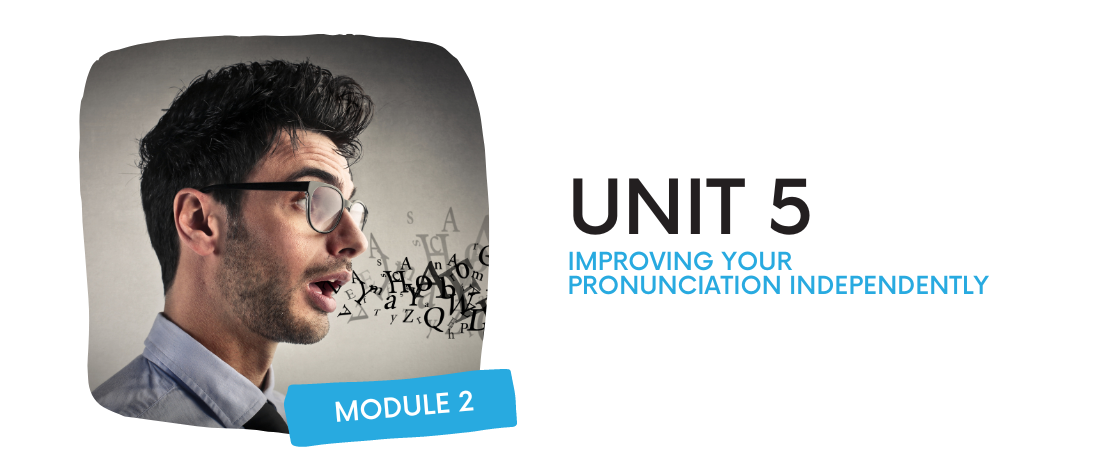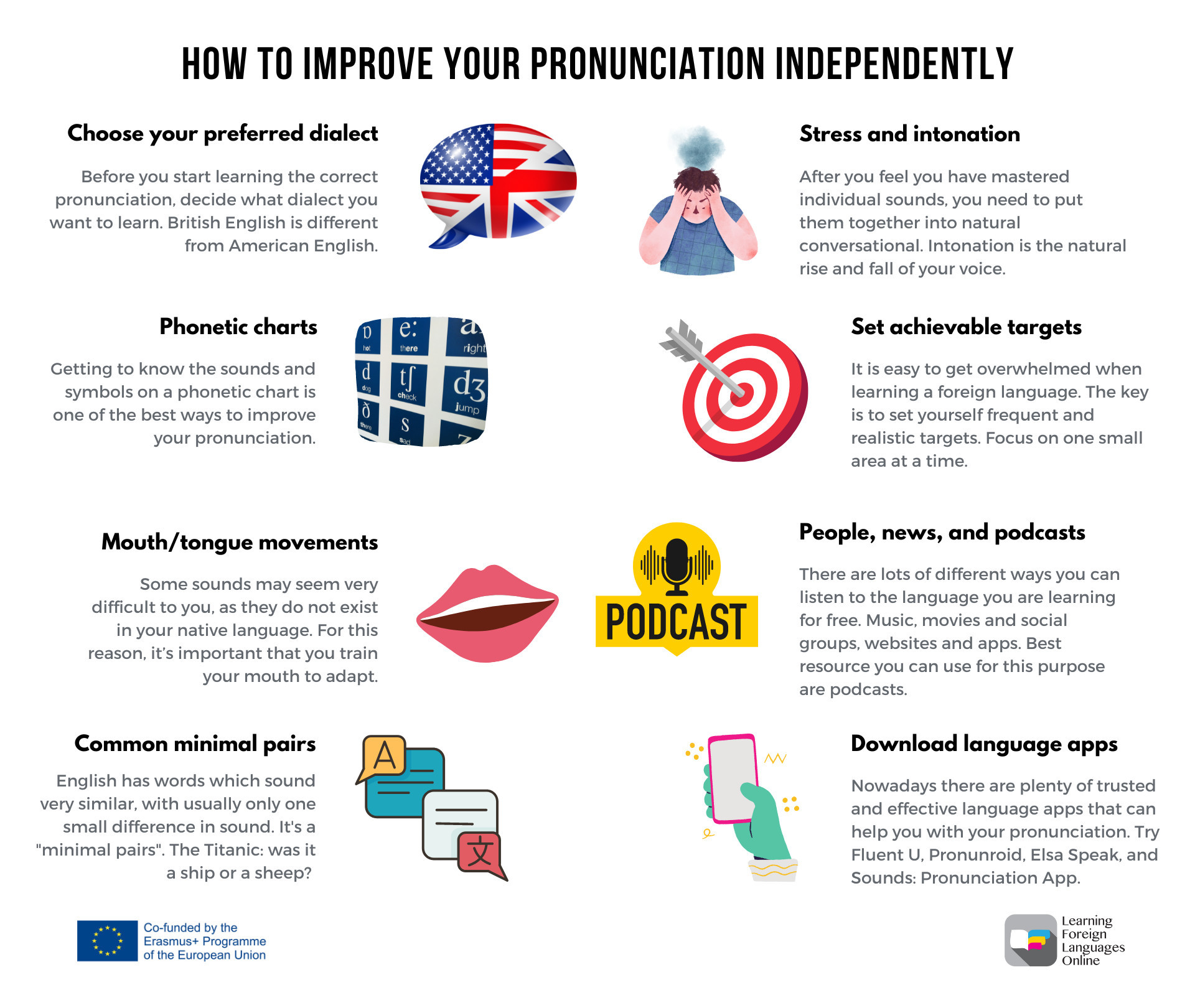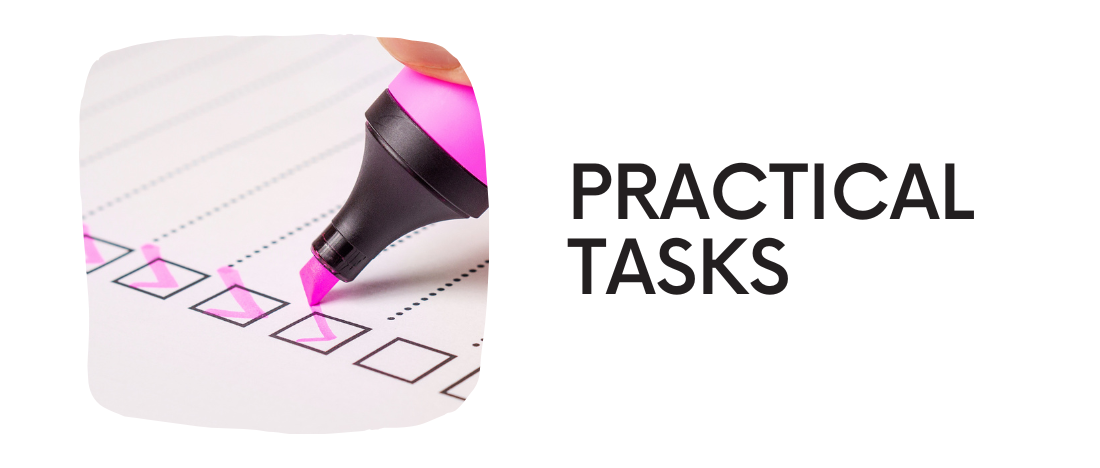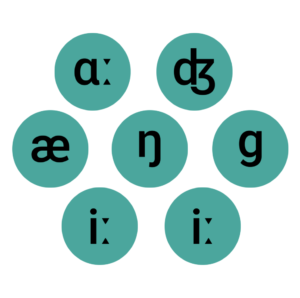
E-course
Improving your pronunciation independently
Module 2 | Unit 5
Introduction

Even when you’re motivated and seem to be making steady progress as a language learner you may still find that your conversations are not going as well as they could be. This could be because of your pronunciation. Of course, you don’t need to have the same pronunciation as a native speaker, but you do need to be clear and easily understood. Being asked to repeat yourself is frustrating both for you and the other speakers. There are lots of ways you can improve your pronunciation, if you put the effort in you can make your pronunciation better and learn to enjoy conversations without needing to stop to try and explain what word you are using.
Getting started

Tips
9 tips on how to improve your pronunciation independently

1. Choose your preferred dialect
Before you learn how to say a word correctly, it is important that you know the dialect that you want to learn. For example, if you are a learner of English, do you want to learn British English or US English? This decision is important because words are pronounced differently by speakers in different countries. Keeping with the example of English, in British English the stress of a word is different to US English. For example, in the UK, the word ‘adult’ has the stress at the beginning ‘AD-ult’, whereas in the US it’s at the end, ‘ad-ULT’
2. Phonetic charts are your friend
OK, it doesn’t sound like much fun. But getting to know the sounds and symbols on a phonetic chart is one of the best ways to improve your pronunciation.
The IPA (international phonetic alphabet) and phonetic charts for different languages are an international visual representation of all the sounds found in different languages.
This can help, especially when you learn languages in which words might be spelled and pronounced completely differently.
Dictionaries also contain a phonetic transcription of words, including online ones, so you can easily listen to how words are pronounced as you look them up.
3. Practise the physical mouth/tongue movements
Pronunciation is essentially a physical skill; it is about teaching your mouth and tongue movements.
Some sounds may seem very difficult to you, as they do not exist in your native language. For this reason, it’s important that you train your mouth to adapt. Just like a dance or sports class,
It is about daily regular exercise and training – the more you practise, the easier it will get! So, get yourself in front of a mirror and start practicing the different mouth sounds.
Try a new one every day or every few days. Watch how your tongue and lips interact with different consonant and vowel sounds. You can compare your mouth movements with that of a native speaker saying the same word or phrase.
4. Get to know common minimal pairs
The Titanic: was it a ship or a sheep? Practice saying both words.
English, like many other languages, has many examples of so-called ‘minimal pairs – words which sound very similar, with usually only one small difference in sound.
Another example: sonar and soñar in Spanish.
This can be difficult for many non-native speakers, but the first step is to learn the difference between similar words.
There are many great online resources to practise hundreds of different minimal pairs.
5. Pay close attention to your stress and intonation
After you feel you have mastered individual sounds, you need to put them together into natural conversational sentences that other people can understand.
Think about intonation and stress!
Intonation is the natural rise and fall of your voice.
Stress is about which syllables/parts of words you choose to make louder or clearer – for example, the three-syllable ‘RES-taur-ant’ in English.
Think about connected speech.
Try listening to your favorite song lyrics and pay attention to which words/syllables are stressed. Repeat them. Practise reading different things aloud – speeches, news reports or poems.
6. Set achievable/realistic pronunciation targets
It is easy to get stressed and overwhelmed when learning a foreign language where there may be many words with different spellings and ways of pronouncing them!
How can you possibly remember all the different sounds in all these words? The key is to set yourself frequent and realistic targets.
Focus on one small area of pronunciation at a time. For example, you may want to focus on one individual sound for a while until you feel that you have good control of this sound.
Test yourself and get others to test you. Set aside some time in your schedule – perhaps half an hour per day.
7. Listen to people, news, and podcasts
This is a great way to become familiar with different accents.
Pay attention to the intonation people use in different situations – does their voice rise or fall at the end when they are surprised about something, telling a joke, or asking a question?
Try to remember short phrases you hear and repeat them to yourself afterwards with the correct tone and word stress.
There are lots of different ways you can listen to the language you are learning for free – from music, movies and social groups to websites and apps.
One of the absolute best resources you can use for this purpose are podcasts. These are normally free and there are lots of them for you to download on your device so you can listen wherever and whenever you want, perhaps while on the bus or walking in the park.
8. Download popular pronunciation/language apps.
Nowadays there are plenty of trusted and effective language apps that can help you with your pronunciation.
These apps are usually free!
They will provide you with video lessons on pronunciation topics and test your progress with listening and speaking quizzes.
They are an interactive and fun way to learn and to connect with other learners as well as native speakers!
You can try – Fluent U, Pronunroid, Elsa Speak, and Sounds: Pronunciation App.

More resources

Still want to continue learning about the topic of this unit? Not to worry, we have made a selection of further resources that you can use if you would like to find out more. Just click on the links and keep learning!
Practical tasks

 Find a phonetic chart for the language you are learning online. Can you say the sounds? Many phonetic charts come with audio for the different sounds, try using charts with this feature. Write a list of 50 words you have learned, then write how they are pronounced using the phonetic chart. Continue practicing pronunciation by writing all the new words phonetically.
Find a phonetic chart for the language you are learning online. Can you say the sounds? Many phonetic charts come with audio for the different sounds, try using charts with this feature. Write a list of 50 words you have learned, then write how they are pronounced using the phonetic chart. Continue practicing pronunciation by writing all the new words phonetically.
 Find some minimal pairs in the language you are learning. Can you recognize the differences in sounds between the words? Can you also produce the different sounds correctly? Create a separate document for writing down minimal pairs you encounter while learning a foreign language. Find at least 5 every month.
Find some minimal pairs in the language you are learning. Can you recognize the differences in sounds between the words? Can you also produce the different sounds correctly? Create a separate document for writing down minimal pairs you encounter while learning a foreign language. Find at least 5 every month.
 Write a list of 50 words you know in the language you are learning with three to five syllables. Then, try to underline the stressed syllable in each word. Use a dictionary to check whether you were right. Continue underlining stressed syllables in all other words you are learning.
Write a list of 50 words you know in the language you are learning with three to five syllables. Then, try to underline the stressed syllable in each word. Use a dictionary to check whether you were right. Continue underlining stressed syllables in all other words you are learning.
 Set one realistic pronunciation goal. Rather than aiming to achieve perfect pronunciation in the language you are learning, you may want to begin by trying to get better at using one particular sound or one particular word. Set a timeline for getting better and decide on the steps you are going to take to achieve this goal. For example, you will give yourself a week to learn how to pronounce a particular sound and in the meantime write 10 words containing this sound. Every day, create two sentences containing two of these words and practice saying them in front of a mirror.
Set one realistic pronunciation goal. Rather than aiming to achieve perfect pronunciation in the language you are learning, you may want to begin by trying to get better at using one particular sound or one particular word. Set a timeline for getting better and decide on the steps you are going to take to achieve this goal. For example, you will give yourself a week to learn how to pronounce a particular sound and in the meantime write 10 words containing this sound. Every day, create two sentences containing two of these words and practice saying them in front of a mirror.
 A really helpful task for beginning learners, who want to learn a very different new language from theirs, and with sounds that differ from your native language, is to listen to a slow and easy recording. Now, choose a new sound, that tricky one that is difficult for you, and on a sheet of paper try to note down how many times you hear it. When you do this exercise, focus on particular sounds of your target language in order to tell them apart when you listen to someone speak and then you can try to imitate them. This exercise will also help you with your speaking.
A really helpful task for beginning learners, who want to learn a very different new language from theirs, and with sounds that differ from your native language, is to listen to a slow and easy recording. Now, choose a new sound, that tricky one that is difficult for you, and on a sheet of paper try to note down how many times you hear it. When you do this exercise, focus on particular sounds of your target language in order to tell them apart when you listen to someone speak and then you can try to imitate them. This exercise will also help you with your speaking.
Unit test

